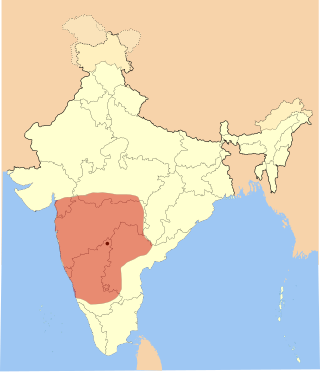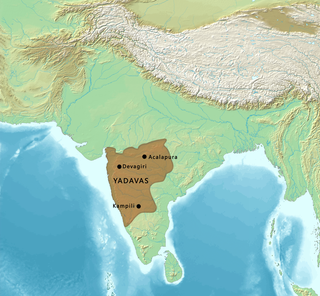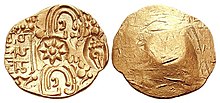
Tailapa II, also known as Taila II and by his title Ahavamalla, was the founder of the Western Chalukya dynasty in southern India. Tailapa claimed descent from the earlier Chalukyas of Vatapi, and initially ruled as a Rashtrakuta vassal from the Tardavadi-1000 province in the modern Bijapur district of Karnataka. When the Rashtrakuta power declined following an invasion by the Paramara king Siyaka, Tailapa overthrew the Rashtrakuta king Karka II, and established a new dynasty.

The Western Chalukya Empire ruled most of the western Deccan, South India, between the 10th and 12th centuries. This Kannadiga dynasty is sometimes called the Kalyani Chalukya after its regal capital at Kalyani, today's Basavakalyan in the modern Bidar District of Karnataka state, and alternatively the Later Chalukya from its theoretical relationship to the 6th-century Chalukya dynasty of Badami. The dynasty is called Western Chalukyas to differentiate from the contemporaneous Eastern Chalukyas of Vengi, a separate dynasty. Prior to the rise of these Chalukyas, the Rashtrakuta empire of Manyakheta controlled most of Deccan and Central India for over two centuries. In 973, seeing confusion in the Rashtrakuta empire after a successful invasion of their capital by the ruler of the Paramara dynasty of Malwa, Tailapa II, a feudatory of the Rashtrakuta Dynasty ruling from Bijapur region defeated his overlords and made Manyakheta his capital. The dynasty quickly rose to power and grew into an empire under Someshvara I who moved the capital to Kalyani.

The Seuna, Sevuna, or Yadavas of Devagiri was a Medieval Indian dynasty, which at its peak ruled a kingdom stretching from the Narmada river in the north to the Tungabhadra river in the south, in the western part of the Deccan region. Its territory included present-day Maharashtra, North Karnataka and parts of Madhya Pradesh, from its capital at Devagiri.

The Paramara dynasty was an Indian dynasty that ruled Malwa and surrounding areas in west-central India between 9th and 14th centuries. They belonged to the Parmara clan of the Rajputs.
Arjunavarman was an Indian king from the Paramara dynasty, who ruled in the Malwa region of central India.
Simhana (IAST: Siṃhaṇa, also transliterated as Singhana; r. c. 1210-1246 was the most powerful ruler of the Seuna dynasty of Deccan region in India. He expanded his kingdom southwards at the expense of the Hoysalas, and fought the Chaulukyas and the Vaghelas for the control of the Lata region in the north. He also defeated the Paramaras of Malwa, the Shilaharas of Kolhapur and the Rattas of Belgaum. His generals subjugated several insubordinate feudatory chiefs, and the Yadava territory reached its greatest extent during his reign.

The Chaulukya dynasty, also Solanki dynasty, was a dynasty that ruled parts of what are now Gujarat and Rajasthan in north-western India, between c. 940 CE and c. 1244 CE. Their capital was located at Anahilavada. At times, their rule extended to the Malwa region in present-day Madhya Pradesh. The family is also known as the "Solanki dynasty" in the vernacular literature. They belonged to the Solanki clan of Rajputs.
Munja, also known as Vakpati II, was an Indian ruler from the Paramara dynasty, who ruled in the Malwa region. He is known for consolidating the Paramara kingdom, for patronizing poets and scholars and for achieving the military success against almost all of the neighbouring kingdoms.

The 11th century Paramara king Bhoja ruled from his capital at Dhara. The period of his reign is dated approximately 1010 CE to 1055 CE, although some historians believe that he ascended the throne before 1010 CE. Bhoja inherited a kingdom centered around the Malwa region, and made several attempts to expand it varying results. He managed to annex territories as far as northern parts of Konkan, but these territorial gains were short-lived. He fought wars against several of his neighbours, including the Chaulukyas of Gujarat, the Chalukyas of Lata, the Chalukyas of Kalyani, the Chandelas of Jejakabhukti, the Kachchhapaghatas of Gwalior, the Chahamanas of Shakambhari, the Chahamanas of Naddula, and the Kalachuris of Tripuri. He also conflicted with Gaznavid Turk Invaders, Mahmud's desecration of the Somnath temple in Gujarat motivated Bhoja to lead an army against him, however after Somnath raid, Mahmud Gazhnavi chose a more dangerous route via Sindh, to avoid facing the invading powerful armies of Bhoja.
Jayavarman, also known as Ajayavarman, was an Indian king from the Paramara dynasty, who ruled in the Malwa region of central India. He appears to have recaptured the Paramara capital Dhara after a Chaulukya occupation of the city. Sometime later, an usurper named Ballala became the control of the city, and Jayavarman appears to have moved to a newly-created principality in the Bhopal area.
Jaitugi, also known as Jaitrapala, was a ruler of the Seuna (Yadava) dynasty of Deccan region in India.
Vindhyavarman was an Indian king from the Paramara dynasty, who ruled in the Malwa region of central India. He defeated the Chaulukyas, who had annexed the Paramara territory to their own kingdom in the preceding years.
Subhatavarman, also known as Sohada, was an Indian king from the Paramara dynasty, who ruled in the Malwa region of central India.
Bhima II, also known as Bhola Bhima, was an Indian king who ruled parts of present-day Gujarat. He was a member of the Chaulukya dynasty. During his reign, the dynasty's power declined greatly as a result of rebellions by the feudatories as well as external invasions by the Ghurids, the Paramaras, and the Yadavas of Devagiri. The kingdom, however, was saved by his generals Arnoraja, Lavanaprasada and Viradhavala, whose family established the Vaghela dynasty.
Kelhana-deva was an Indian king belonging to the Naddula Chahamana dynasty. He ruled the area around Naddula, as a Chaulukya vassal. He participated in the 1178 CE Battle of Kasahrada, in which the Chaulukya forces defeated the Ghurid ruler Muhammad of Ghor.

Ramachandra, also known as Ramadeva, was a ruler of the Seuna (Yadava) dynasty of Deccan region in India. He seized the throne from his cousin Ammana, after staging a coup in the capital Devagiri. He expanded his kingdom by fighting his Hindu neighbours such as the Paramaras, the Vaghelas, the Hoysalas, and the Kakatiyas.
Krishna, also known as Kanha or Kannara, was a ruler of the Seuna (Yadava) dynasty of Deccan region in India. He successfully invaded the Paramara kingdom of Malwa, and fought inconclusive wars against the Vaghelas and the Hoysalas. The Yadava inscriptions also credit him or his generals with several other victories, but these claims are of doubtful veracity.

Mahadeva was a ruler of the Seuna (Yadava) dynasty of Deccan region in India. He succeeded his brother Krishna on the throne.
Bhillama II was a ruler of the Seuna (Yadava) dynasty of Deccan region in India. He was a vassal of the Kalyani Chalukya ruler Tailapa II, and played an important role in Tailapa's victory against the Paramara king Munja.
Rudra-deva was a Kakatiya king, who ruled parts of the present-day Telangana and Andhra Pradesh in southern India. He was the first sovereign ruler of his dynasty.








